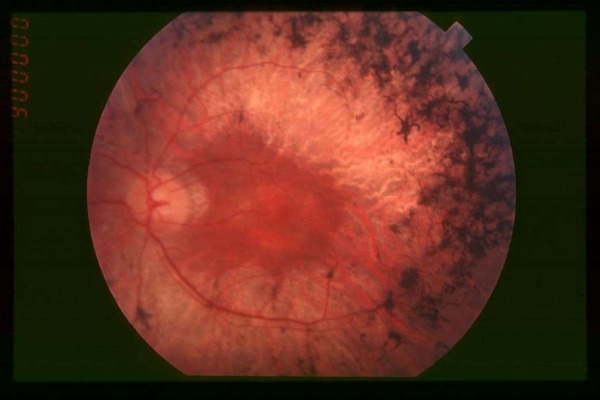Genetics using CRISPR have removed the defective gene, leading to retinal degeneration

Retina affected by retinitis pigmentosa
Genetics from the Columbia University Medical Center have announced the successful editing of stem cells, ridding them of a genetic mutation leading to a degenerative eye disease called “retinitis pigmentosa”. Stem cells whose genome has been modified using modern CRISPR gene editing technology were created from the patient's skin.
Retinitis pigmentosa ( Retinitis pigmentosa , RP) is a hereditary, degenerative disease of the retina that causes severe visual impairment and often blindness. The progression of RP is not consistent - some people develop symptoms in childhood, others may notice symptoms later. Symptoms include tunnel vision, which narrows the angle of peripheral vision. Currently, about one and a half million people are registered with this disease.
')
Video explaining the details of the disease
In 90 percent of cases, the presence of RP in humans is due to one mutation in the RGPR gene. The researchers suggested that by inserting working cells that do not have this mutation into the retina, the process of its degradation can be stopped or even completely eliminated. Naturally, this requires somewhere to get working cells of the retina, which would not be rejected by the patient's body.
The procedure took place in two stages. First, scientists, taking samples of the skin, obtained pluripotent stem cells (such cells, which can then turn into cells of any tissue ) from these cells. And then, using the CRISPR gene editing technology, they corrected these cells and removed the harmful mutation from them. Editing cells in vitro took 10 days.
Theoretically, stem cells obtained without genetic defects can save people from the disease, and restore the retina from the eyes. Such experiments have already been carried out on monkeys and ended in success. And while genetic modifications of human embryos are strictly prohibited, modifications of human cells and individual organs are completely acceptable. Ophthalmological surgeons have already quite well studied the structure of the eyes and are able to carry out various operations for the introduction of tissue, in connection with which the authors of the work are very optimistic .
Source: https://habr.com/ru/post/371697/
All Articles